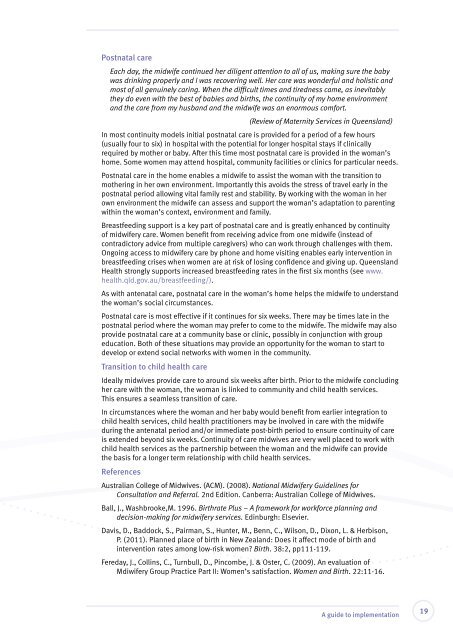Delivering continuity of midwifery care to Queensland women
Delivering continuity of midwifery care to Queensland women
Delivering continuity of midwifery care to Queensland women
Create successful ePaper yourself
Turn your PDF publications into a flip-book with our unique Google optimized e-Paper software.
Postnatal <strong>care</strong><br />
Each day, the midwife continued her diligent attention <strong>to</strong> all <strong>of</strong> us, making sure the baby<br />
was drinking properly and I was recovering well. Her <strong>care</strong> was wonderful and holistic and<br />
most <strong>of</strong> all genuinely caring. When the difficult times and tiredness came, as inevitably<br />
they do even with the best <strong>of</strong> babies and births, the <strong>continuity</strong> <strong>of</strong> my home environment<br />
and the <strong>care</strong> from my husband and the midwife was an enormous comfort.<br />
(Review <strong>of</strong> Maternity Services in <strong>Queensland</strong>)<br />
In most <strong>continuity</strong> models initial postnatal <strong>care</strong> is provided for a period <strong>of</strong> a few hours<br />
(usually four <strong>to</strong> six) in hospital with the potential for longer hospital stays if clinically<br />
required by mother or baby. After this time most postnatal <strong>care</strong> is provided in the woman’s<br />
home. Some <strong>women</strong> may attend hospital, community facilities or clinics for particular needs.<br />
Postnatal <strong>care</strong> in the home enables a midwife <strong>to</strong> assist the woman with the transition <strong>to</strong><br />
mothering in her own environment. Importantly this avoids the stress <strong>of</strong> travel early in the<br />
postnatal period allowing vital family rest and stability. By working with the woman in her<br />
own environment the midwife can assess and support the woman’s adaptation <strong>to</strong> parenting<br />
within the woman’s context, environment and family.<br />
Breastfeeding support is a key part <strong>of</strong> postnatal <strong>care</strong> and is greatly enhanced by <strong>continuity</strong><br />
<strong>of</strong> <strong>midwifery</strong> <strong>care</strong>. Women benefit from receiving advice from one midwife (instead <strong>of</strong><br />
contradic<strong>to</strong>ry advice from multiple <strong>care</strong>givers) who can work through challenges with them.<br />
Ongoing access <strong>to</strong> <strong>midwifery</strong> <strong>care</strong> by phone and home visiting enables early intervention in<br />
breastfeeding crises when <strong>women</strong> are at risk <strong>of</strong> losing confidence and giving up. <strong>Queensland</strong><br />
Health strongly supports increased breastfeeding rates in the first six months (see www.<br />
health.qld.gov.au/breastfeeding/).<br />
As with antenatal <strong>care</strong>, postnatal <strong>care</strong> in the woman’s home helps the midwife <strong>to</strong> understand<br />
the woman’s social circumstances.<br />
Postnatal <strong>care</strong> is most effective if it continues for six weeks. There may be times late in the<br />
postnatal period where the woman may prefer <strong>to</strong> come <strong>to</strong> the midwife. The midwife may also<br />
provide postnatal <strong>care</strong> at a community base or clinic, possibly in conjunction with group<br />
education. Both <strong>of</strong> these situations may provide an opportunity for the woman <strong>to</strong> start <strong>to</strong><br />
develop or extend social networks with <strong>women</strong> in the community.<br />
Transition <strong>to</strong> child health <strong>care</strong><br />
Ideally midwives provide <strong>care</strong> <strong>to</strong> around six weeks after birth. Prior <strong>to</strong> the midwife concluding<br />
her <strong>care</strong> with the woman, the woman is linked <strong>to</strong> community and child health services.<br />
This ensures a seamless transition <strong>of</strong> <strong>care</strong>.<br />
In circumstances where the woman and her baby would benefit from earlier integration <strong>to</strong><br />
child health services, child health practitioners may be involved in <strong>care</strong> with the midwife<br />
during the antenatal period and/or immediate post-birth period <strong>to</strong> ensure <strong>continuity</strong> <strong>of</strong> <strong>care</strong><br />
is extended beyond six weeks. Continuity <strong>of</strong> <strong>care</strong> midwives are very well placed <strong>to</strong> work with<br />
child health services as the partnership between the woman and the midwife can provide<br />
the basis for a longer term relationship with child health services.<br />
References<br />
Australian College <strong>of</strong> Midwives. (ACM). (2008). National Midwifery Guidelines for<br />
Consultation and Referral. 2nd Edition. Canberra: Australian College <strong>of</strong> Midwives.<br />
Ball, J., Washbrooke,M. 1996. Birthrate Plus – A framework for workforce planning and<br />
decision-making for <strong>midwifery</strong> services. Edinburgh: Elsevier.<br />
Davis, D., Baddock, S., Pairman, S., Hunter, M., Benn, C., Wilson, D., Dixon, L. & Herbison,<br />
P. (2011). Planned place <strong>of</strong> birth in New Zealand: Does it affect mode <strong>of</strong> birth and<br />
intervention rates among low-risk <strong>women</strong> Birth. 38:2, pp111-119.<br />
Fereday, J., Collins, C., Turnbull, D., Pincombe, J. & Oster, C. (2009). An evaluation <strong>of</strong><br />
Mdiwifery Group Practice Part II: Women’s satisfaction. Women and Birth. 22:11-16.<br />
A guide <strong>to</strong> implementation<br />
19
















